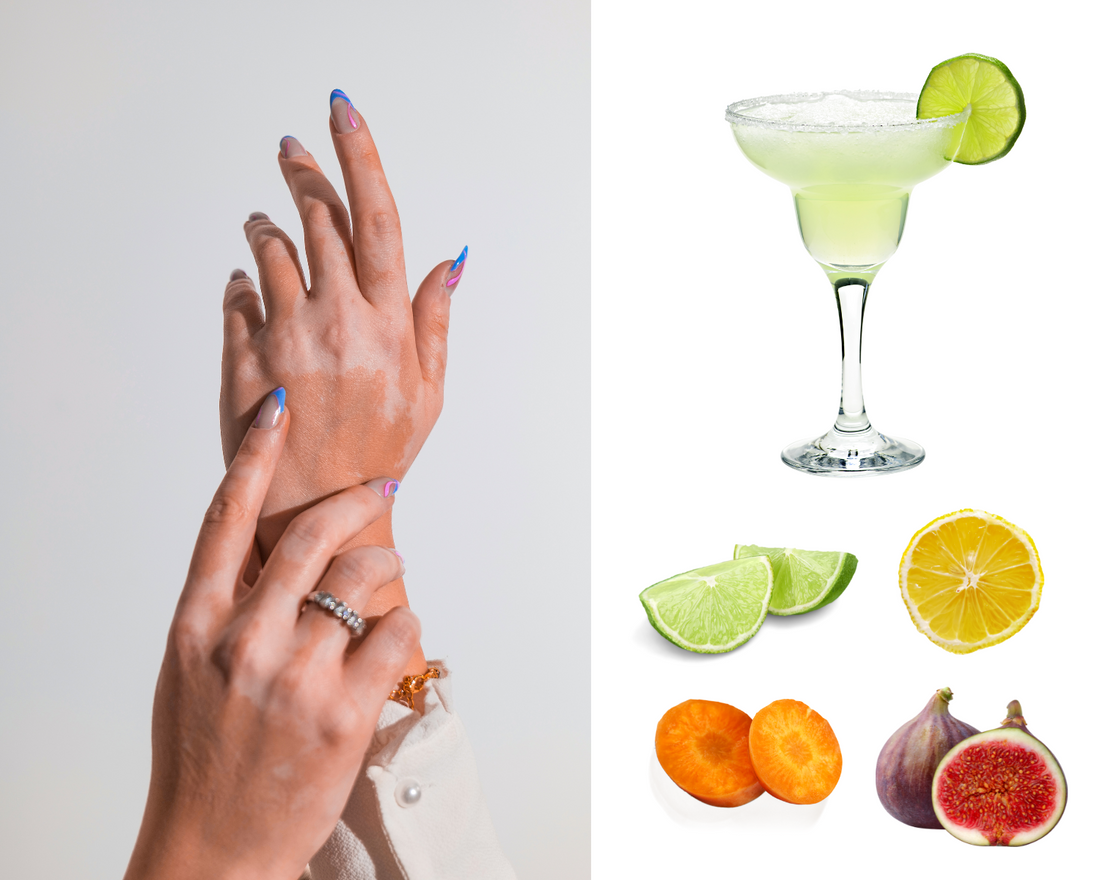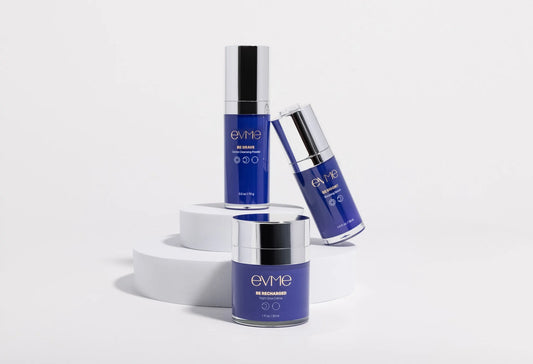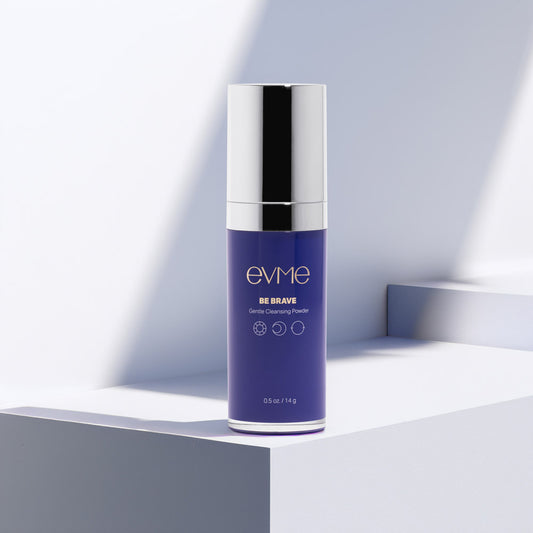Try Evme, allergist-created luxe skincare for sensitive and allergic skin.
Shop All ProductsBest Ways To Soothe Allergic Skin Rashes
August 23, 2022

When you’re dealing with an allergic skin rash, the first thing you want to do is make it go away, right?
With inaccurate diagnostic tests and outdated solutions for topical skin allergies, it can be quite the challenge. So, as a scientist and allergist who also has sensitive skin, I have made it my mission to help people with skin allergies and sensitivities have a better quality of life. Over the last decade, I’ve learned a lot about what types of products cause people to react and what people need to help their skin be less reactive.
Here are some simple steps you can follow to determine the type of allergic reaction you have, learn its triggers, soothe it until it resolves itself, and ideally avoid getting it again!
1. Try to Identify the Rash Trigger and Type
Different types of allergic skin rashes have various triggers. Identifying what triggered your rash is key to determining the best treatment solution. It will also help you avoid getting a similar rash in the future.
Eczema (AKA Atopic Dermatitis)
Causes: A majority of eczema is not food related, though most people relate eczema to food allergies. Your eczema could also be caused by genetic or environmental factors or worsened by irritating ingredients. Eczema is actually caused by a broken skin barrier, so treatment focuses on restoring your skin barrier and replenishing the moisture that is lost.
What it looks like: Eczema has a significant itch-rash cycle which causes itchy flare-ups that result in further rashing. With eczema, skin generally appears dry and scaly, often in patches that can be red and flaky. Eczema is often seen in the arm and leg folds and on the neck, though it really can occur anywhere.
Contact Dermatitis
Causes: This uncomfortable rash is caused by direct contact of your skin with a substance to which you are allergic, such as personal care products, fragrances, or jewelry. It is generally a delayed reaction, starting 48-72 hours after exposure.
What it looks like: Contact Dermatitis can show up as a red, dry, scaly, and bumpy rash with occasional blistering. Eyelids can be affected, with dryness and flakiness around the eye area. Even after switching to a simple and gentle routine and eliminating all potential topical allergens, it can still take several weeks to clear up the rash.
Hives
Causes: This rash comes on quickly and is the most serious of skin reactions. It can be secondary to food reactions, environmental triggers like grass pollen or cat dander, or reactions to viruses. It may also potentially be due to medications.
What it looks like: Hives often look like mosquito bites when they start, with a red base and swelling of the skin, but have the potential to progress in size quickly. It is extremely itchy and uncomfortable, and often requires immediate treatment with anti-histamines. How can you tell the difference between hives and mosquito bites? Hives move around the body and don’t tend to last in the same place for more than a couple hours, whereas mosquito bites are “fixed” in place and will be in the same spot for several days.
2. Simply Your Routine
Take non-essential personal care items out of your routine and stick with the basics like cleanser and moisturizer for your face and body, shampoo and conditioner for your hair, and minimal or no makeup.
Although it may be difficult to go down to the bare bones like this, it is helpful to stay simple and gentle until you determine what you’re allergic to and clear up your rash. At the very least, look for products without fragrance and dyes, and products which contain only a few ingredients. Ideally choose products that are labeled “fragrance free” NOT “unscented.”
And remember: Labels like “clean” and “natural” do not mean that they are less allergenic.
3. Moisturize, Moisturize, Moisturize
Keeping your skin moisturized is important to maintaining your skin’s overall health and barrier function, allergies or not. It’s also important to know that allergic rashes respond well to moisturization. But make sure that you use a hydrating cream rather than a lotion or gel. Why? Lotions and gels are water-based, while creams tend to be oil-based. Creams have better staying power on the skin. And of course, look for creams without any added color or fragrance.
What can you do after you moisturize to maintain the moisturization effect for hours on end? After moisturizing with a cream, seal in the moisture with a barrier product, such as a purified petroleum jelly like Vaseline. This allows the cream to stay in place and work longer.
Petroleum jelly gets a bad rap due to the obvious word in its name, but rest assured it’s not actually petroleum! And it is very safe for people with allergies and sensitive skin. However, stay away from petroleum jellies that can be mixed with potential allergens. For example, the brand Aquaphor, has a known allergen in it called lanolin (which helps make it spread a little easier), but can be allergenic to some people.
4. Consider Natural and Medicinal Treatments
Natural
- Ice: Though it may seem basic, ice can actually be a really helpful solution to help ease symptoms of an allergic rash, such as pain and swelling. Plus, we get a lot of extra blood flow to rashes, which makes them red and causes the inflammation to progress. So, ice not only feels good, but also helps slow down the buildup of inflammatory factors.
- Keep cool: Sweating and extra humidity can make rashes worse. Look for shade and air-conditioned areas to chill in when you can.
- Wear light, loose-fitting clothes: Wear breathable materials like cotton to keep the rash from getting further irritated.
Medicinal
- Topical corticosteroids: There’s no need to fear this since the over-the-counter stuff is not very potent! Start with OTC steroid creams like hydrocortisone. This helps to reduce mild inflammation in your skin, but is not the answer if you have more severe rashing, or rashes all over your body. Cortisones work best when you are treating a small portion of your body like your neck or your hands. If you need to use cortisone daily for longer than a week, it is best to consult your doctor to figure out if you need something different or stronger.
- Antihistamines: Oral, non-sedating anti-histamines are easy to find at drugstores and can be helpful at reducing the itch that goes along with allergic rashes. These can be particularly helpful for reactions like hives or swelling, but not as useful for topical skin allergies or eczema. For hives and swelling, these can help get rid of the reaction and treat it. However, for topical skin allergies or eczema, they help more symptomatically with itch, but do not make the rash go away.
Recommended articles
Evme Sans-Allergenic Skincare Products
- Choosing a selection results in a full page refresh.













